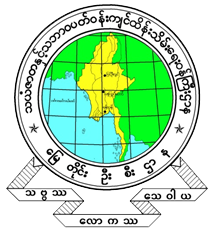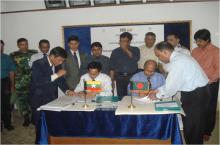Office of the Director General
Office of the Director General
From 1905 to World War II , under the British rule, all the surveying works of Myanmar were undertaken by the Survey of India. At the end of World War II, the British government separated surveying works of Myanmar from Survey of India. On 1st November 1946, Burma Survey Department was formed under the Ministry of Finance and Revenue by the British Government.
Director Generals of Survey Department were as follow:-
|
NO |
NAME |
DURATION |
|
1 |
Sithu Colonel Hla Aung |
1959-1975 |
|
2 |
Wana Kyaw Htin U R Hla Kyaw |
1976-1981 |
|
3 |
Wana Kyaw Htin U Lun Bay |
1981-1982 |
|
4 |
Wana Kyaw Htin U Sein Lwin |
1982-1988 |
|
5 |
U Maung Maung |
1988-1991 |
|
6 |
U Mya Thein |
1991-1992 |
|
7 |
Colonel Htun Aung |
1993-1995 |
|
8 |
U Aung Than |
1995-1997 |
|
9 |
U Maung Maung Tin |
2001-2004 |
|
10 |
U Myint Thein |
2004-2007 |
|
11 |
U Than Hlaing |
2012-2018 |
|
12 |
U Thet Oo |
2018 - Up to Now |
On 1st March 1990, during the reign of the State Law and Order Restoration Council, Survey Department was formed with a new set-up consisting of six divisions:
(a) Office of the Director General
(b) Aerial Survey and Photography Division
(c) Map Reproduction Division
(d) Geodetic and No.(2) Survey Division
(e) International Boundary and Civil Construction Survey Division
(f) Training and No.(1) Survey Division
Organizational Structure and Manpower
The organizational structure and strength of staff capacity at the end of March, 2024 are as follow.
Organization Structure
Manpower
|
|
Strength |
Posted |
Vacancy |
|
Officers Other Ranks |
15 143 |
13 53 |
2 90 |
|
Total |
158 |
66 |
92 |
Tasks of Office of Director General
(1) The objectives, policies and directions of the state and ministry distributes to
sub divisions as well as hints for following.
(2) Making plans for surveying, map drawing and map printing.
(3) Selecting the civil service by set-up and strength
(4) Promating to civil service and undertaking personal.
(5) Applying budgets from national planning and contribute as per amount rationally.
(6) Directing the budgets to follow the budget policy.
(7) Indicating the civil services to be good for their moral and discipline.
(8) Arranging high tech training
(9) Listing the plans and reports to the ministry and higher level.
(10) Cooperating with international organization.
(11) Arranging workshop and researching letters among the civil service.
(12) Arranging to send aboard training course and internal advance course.
(13) Making welfare for staff and arranging furry to attend office.
(14) Arranging the printed maps to sell.
Developed By Bagan Innovation Technology


 မြန်မာဘာသာ
မြန်မာဘာသာ 


